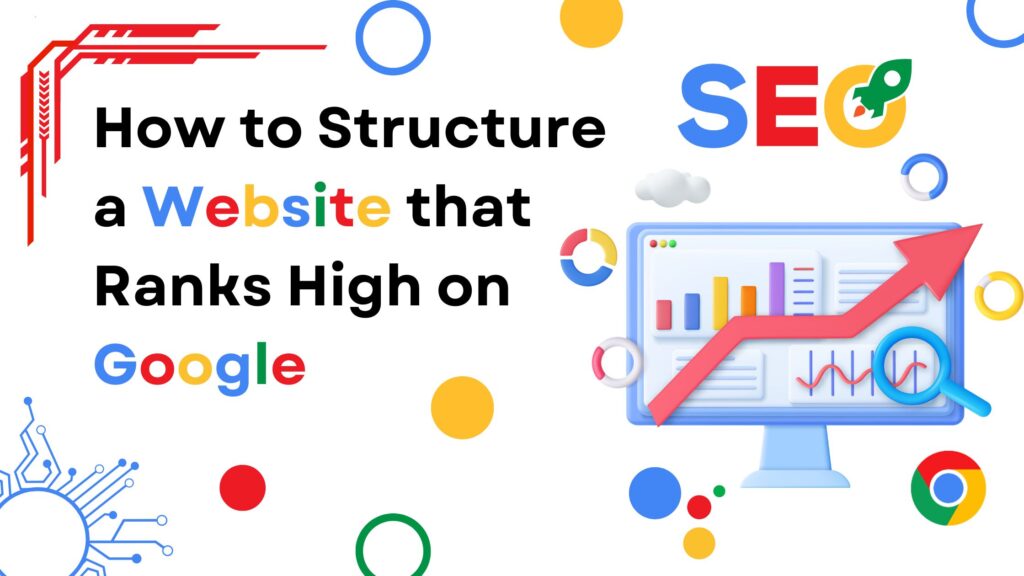
Ranking a website on Google is not an easy task. You might know that very well if you happen to own a website. It becomes a matter of concern when the website doesn’t rank well, thus attracting less traffic. But have you ever wondered why your website is ranking poorly? It could be because of your website structure.
What is a Website Structure?
In simple terms, it means how and where the content on your website is arranged. How you design the website and connect the webpages with one another for a seamless user journey plays a crucial part in the website ranking well on Google.
Suppose you come to a library planning to borrow a good book. But you find out that the shelves do not have the books arranged in chronological order making it difficult for you to find the desired book. This will leave you with a bad impression of the library. You might not even want to visit it again.
Similarly, how a website is structured greatly affects a user’s experience.
Why is Website Structure important?
Google will understand your website better
Good website architecture makes it easier for Google to find and index your web pages. Why? Because a well-designed website helps Google properly understand the purpose of the page and where to find all the important content. This way Google is able to showcase relevant information to people.
Also, having more internal links on your website makes it seem more important to Google, thus helping in higher ranking and visibility.
To avoid keyword cannibalization
When several pages or posts on a website target the same keyword phrases or topic, it creates a phenomenon called keyword cannibalization. It is essentially like your website competing with itself! This negatively impacts the ranking of the website.
To avoid this occurrence, unique content should be created and structured logically so that the crawlers can get a clear idea of the intention behind each content piece.
For a better user experience
When viewers come to your website they should have a good browsing experience, which is why a solid site structure is essential. The site should be designed in a way that is easier for people to look around it without much confusion. It should be enticing and attractive enough that the viewers go deeper into the website instead of leaving the page after a few seconds. This can lead to better conversions.
Types of Website Structure
There are in total 4 main types of site structure. They are as follows:
1. Hierarchical Layout
This is a very popular structure type which is also known as tree model. It is usually used for websites that contain loads of information that require to be organized to make the searching process easy and efficient. Basically, a hierarchical model uses a top-down approach that guides users from a home page that branches out into various sub-pages or child pages.
2. Database Model
Also known as dynamic structure, this is a model that takes a bottom-up approach to shape a website. The whole process is search-driven, that is when you land on a website’s homepage you have to search for content by using keywords. Since the model utilizes metadata and taxonomies, users are able to create their own unique experiences using search tools. Google uses such a model.
3. Linear or Sequential Model
As the name suggests, in this type of model the webpages are connected in a linear manner. That is, you can only move back and forth between the pages. This type of model is mostly used for simple and low-maintenance websites consisting of only a few pages.
4. Matrix Structure
This model is also commonly known as webbed model. It interlinks various parent pages with subpages thus creating the ability to access any page with fewer clicks. It allows users to navigate pages and explore content in a relaxed manner.
This type of site structure is best suited for e-commerce websites.
How to Choose the Right Structure for Your Website?
So now you want to create a structure for your website that aligns with your requirements. How to do that? Here are the steps.
Your first course of action should be identifying the main objectives of your website. Determine whether your website is a blog website, e-commerce, portfolio, or informational website. This will give you a better idea of what type of structure you should make.
Next, you need to consider the type of content you want to include on your website. This could be in the form of articles, quizzes, surveys, blog posts, photos, or videos. Categorize all the content in accordance with their importance.
Make sure to also do thorough research on the target audience’s browsing habits, preferences, and the devices they use the most to access the internet.
How to Design Good Website Architecture?

Optimize your website for the target audience
While website owners need to think about crawl bots for better ranking, optimizing for the target audience should be the priority. Your ultimate goal is attracting website traffic. But if your website is disorganized, the audience won’t like it and leave the page.
You have to make sure that the website is mobile-friendly, responsive, easy to navigate, and loads fast. Use headings, subheadings, and bullet points to make it convenient for users to go through the website content.
A cluttered website is a bad website. Avoid cluttering your website with multiple ads that will only distract the audience from the main intent of visiting your website. Besides, when you keep adding more blog posts, articles, products, etc. your website is bound to get jam-packed and messy. Thus it is important to get all the stuff on the website organized so that your audience doesn’t get lost while searching for the information that they want.
Create internal links
Links are ways through which search engine crawlers travel the web. They are hyperlinks that connect one page with another on the same website. When you link relevant pages together, it creates a hierarchical structure that signals to the search engine that the pages are related and important. As a result, your website’s visibility will increase as well as traffic.
So make it a habit of creating strong internal links that point to important pages on your website. The links also help website visitors to navigate to pages that provide valuable and relevant information to them. Not only that, if they easily find content that they deem useful and engaging, they are likely to spend a considerable amount of time on your website. This reduces the bounce rate significantly.
Make sure to use descriptive anchor texts consisting of relevant keywords while linking. What it does is provide search engine bots the ability to fully understand the context and importance of the linked page.
Plan the content hierarchy
Nowadays there is so much content online for consumption that it is hard to keep up with everything. On social media platforms, multiple websites, and various other channels, thousands of content pieces are being published regularly.
With a vast amount of content available, it is not hard to see why the average number of internet users has short attention spans. So when your audience lands on your webpage, you have to instantly grab their attention. How? By strategically placing the most important information in a way that is easily accessible to people.
Identify the main topics and categories that your website will cover and align them with target keywords. After that, create subcategories that will come under each main category or topic. These categories and subcategories should be meaningful and reflect your content goals. Break down your content into easily digestible chunks and use bullet points wherever required. Also, consider using headings and subheadings filled with focus keywords while structuring the content.
A well-structured content hierarchy goes a long way in making the reading experience smooth for users.
Create shallow click depths
Click depths basically means the number of clicks that it takes for a user to reach a particular page. Now, according to SEO, the lower the click depth, the better the opportunity to rank high on SERPs. That is because Google prioritizes the websites that will allow users to reach a specific page in a very less number of clicks. Shallow click depths also make it convenient for search engine crawlers to locate and index content efficiently.
If you want to optimize click depth, your focus should be establishing a logical structure for your website. The hierarchy of your website’s navigation menu has to be narrow. That is there should be more top-level categories and less lower-level categories. This will enable the users to access an important page in just a few clicks.
In addition, don’t forget to use internal links. Embed internal links that connect to subpages while creating blogs and articles. By doing this, you’ll make it easier for the users to locate subpages instead of depending on the navigation menu.
Use Schema Markup
Schema Markup or structured data is codes that are placed on web pages. It is a vocabulary for search engines to read and understand the content on websites, thus helping to enhance the visibility of a website. Through schema markup, you can even offer more details like business information, reviews, products, events, etc. which will appear in search results as rich snippets.

The above picture of KDMI (Kolkata Digital Marketing Institute) is just an example of how these snippets look like. Incorporating schema markup into your web pages can improve their visibility, which in turn will boost click-through rates.
Make a Sitemap file
Notice how when you visit a mall, there are maps placed displaying the whereabouts of shops and details of the entire area? Sitemap is similar to that; they work as maps for search engine crawlers. It is a file that contains the URLs of all the important pages on your website. This enables search engines to crawl and locate specific pages easily and effectively.
Creating a well-ordered sitemap is beneficial for your website to rank high on SERPs and drive organic traffic.
Frequently Asked Questions
There are 4 types of site structure types in total- Hierarchical, Database, Linear, and Webbed.
Hierarchical site structure is considered the most common and versatile type of site structure. The reason it is regarded as versatile is because it suits many types of websites.
In general, it is a website developer who creates and designs a site’s structure, alongside UX and UI designers.
Conclusion
In conclusion, a well-organized website matters a lot since it contributes to the overall performance of your website. And by extension, your overall online success. If you wish to have an attractive and SEO-friendly website design, contact us immediately.



